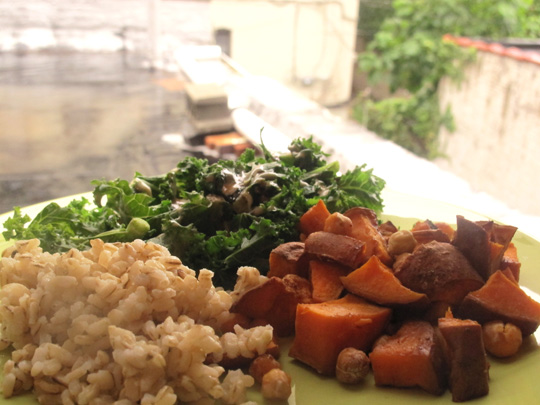According to Wikipedia, the original granola recipe was conceived in 1894, consisted of graham flour and was equivalent to oversized Grape Nuts. Anyone who knows me well can tell you that I speak evocatively over my love for Grape Nuts, my favorite cereal. Reading more about granola, Wiki tells me that the"food and name were revived in the 1960s, and fruits and nuts were added to it to make it a health food that was popular with the hippie movement. At the time, several people claim to have revived or re-invented granola." Without digging into the later controversy and struggle over granola patents and bragging rights, I attempted to re-invent the crunchy, hippie food that's jumped onto the mainstream.
I love granola. I love fruit, I love fruit and granola. I don't eat much of the stuff because it's typically loaded with oils I prefer not to eat, and a lot of sugar. But I'm somewhat of a Grape Nuts-loving hippie and I like a good challenge--doesn't granola seem like it would be easy to make for yourself?
Turns out, it is, and it's a recipe that I could learn to love: you can add anything you want to it!
I based mine off this New York Times recipe. The recipe below includes my modifications. I made this at home in California and would most likely try a tweak using agave and coconut oil back in NYC.
Olive Oil Granola
3 cups old fashioned rolled oats
1/2 cup extra virgin olive oil
1/2 cup maple syrup
1/4 cup honey
1/4 cup packed light brown sugar
1 teaspoon kosher salt
1/2 teaspoon ground cinnamon
1/2 teaspoon nutmeg
1/2 cup chopped, pitted dates
3/4 chopped nuts: walnuts, almonds, cashews
1/4 cup dried cherries
1/4 cup dried, flake coconut
Preheat oven to 300 degrees. In a large bowl, combine oats, nuts, maple syrup, honey, olive oil, brown sugar, salt, cinnamon and nutmeg. Spread mixture on a rimmed baking sheet in an even layer and bake for 20 minutes. Halfway through, remove, add dried fruit and coconut, stir for consistency and return to oven for 25 minutes or until oats become slightly crunchy and golden brown. Remove, cool and store!






















